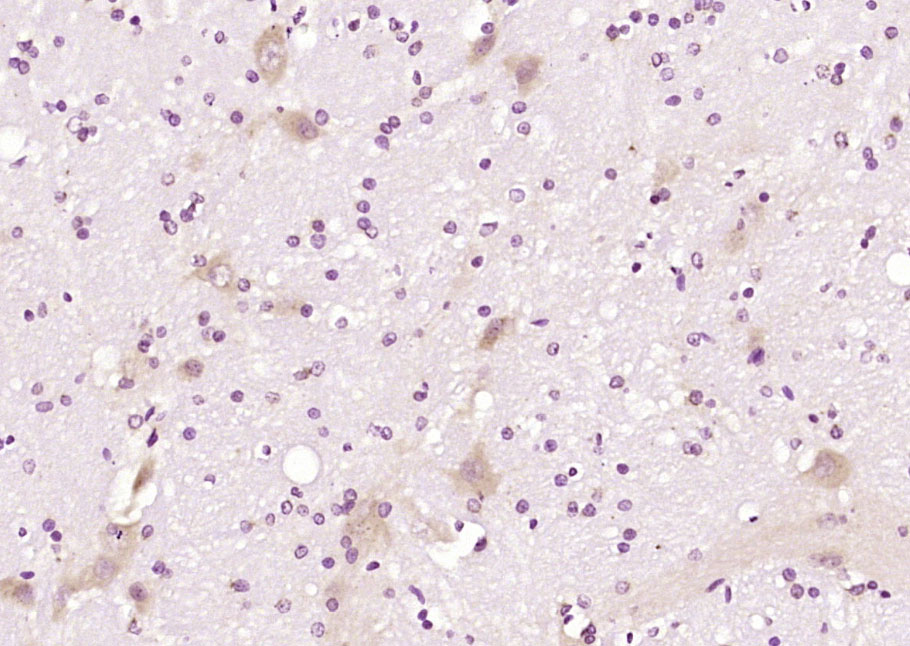DEDD1 Rabbit pAb
DEDD1 Rabbit pAb
- 产品详情
- 实验流程
- 背景知识
Application
| WB, IHC-P, IHC-F, IF |
|---|---|
| Primary Accession | O75618 |
| Reactivity | Human, Rat |
| Predicted | Mouse, Chicken, Pig |
| Host | Rabbit |
| Clonality | Polyclonal |
| Calculated MW | 36794 Da |
| Physical State | Liquid |
| Immunogen | KLH conjugated synthetic peptide derived from human DEDD1 |
| Epitope Specificity | 151-250/318 |
| Isotype | IgG |
| Purity | affinity purified by Protein A |
| Buffer | 0.01M TBS (pH7.4) with 1% BSA, 0.02% Proclin300 and 50% Glycerol. |
| SUBCELLULAR LOCATION | Cytoplasm. Nucleus, nucleolus. |
| SIMILARITY | Contains 1 DED (death effector) domain. |
| SUBUNIT | Interacts with CASP8, CASP10, KRT8, KRT18, CASP3 and FADD. Homodimerizes and heterodimerizes with DEDD2. |
| Post-translational modifications | Exists predominantly in a mono- or diubiquitinated form. |
| Important Note | This product as supplied is intended for research use only, not for use in human, therapeutic or diagnostic applications. |
| Background Descriptions | This gene encodes a protein that contains a death effector domain (DED). DED is a protein-protein interaction domain shared by adaptors, regulators and executors of the programmed cell death pathway. Overexpression of this gene was shown to induce weak apoptosis. Upon stimulation, this protein was found to translocate from cytoplasm to nucleus and colocalize with UBTF, a basal factor required for RNA polymerase I transcription, in the nucleolus. At least three transcript variants encoding the same protein have been found for this gene. |
| Gene ID | 9191 |
|---|---|
| Other Names | Death effector domain-containing protein, DEDPro1, Death effector domain-containing testicular molecule, FLDED-1, DEDD, DEDPRO1, DEFT |
| Target/Specificity | Widely expressed with highest levels in testis. |
| Dilution | WB=1:500-2000,IHC-P=1:100-500,IHC-F=1:100-500,IF=1:100-500 |
| Storage | Store at -20 °C for one year. Avoid repeated freeze/thaw cycles. When reconstituted in sterile pH 7.4 0.01M PBS or diluent of antibody the antibody is stable for at least two weeks at 2-4 °C. |
| Name | DEDD |
|---|---|
| Synonyms | DEDPRO1, DEFT |
| Function | A scaffold protein that directs CASP3 to certain substrates and facilitates their ordered degradation during apoptosis. May also play a role in mediating CASP3 cleavage of KRT18. Regulates degradation of intermediate filaments during apoptosis. May play a role in the general transcription machinery in the nucleus and might be an important regulator of the activity of GTF3C3. Inhibits DNA transcription in vitro (By similarity). |
| Cellular Location | Cytoplasm. Nucleus, nucleolus. Note=Translocated to the nucleus during CD95-mediated apoptosis where it is localized in the nucleoli (By similarity). Following apoptosis induction, the mono and/or diubiquitination form increases and forms filamentous structures that colocalize with KRT8 and KRT18 intermediate filament network in simple epithelial cells. |
| Tissue Location | Widely expressed with highest levels in testis. |
For Research Use Only. Not For Use In Diagnostic Procedures.
Provided below are standard protocols that you may find useful for product applications.
BACKGROUND
This gene encodes a protein that contains a death effector domain (DED). DED is a protein-protein interaction domain shared by adaptors, regulators and executors of the programmed cell death pathway. Overexpression of this gene was shown to induce weak apoptosis. Upon stimulation, this protein was found to translocate from cytoplasm to nucleus and colocalize with UBTF, a basal factor required for RNA polymerase I transcription, in the nucleolus. At least three transcript variants encoding the same protein have been found for this gene.
终于等到您。ABCEPTA(百远生物)抗体产品。
点击下方“我要评价 ”按钮提交您的反馈信息,您的反馈和评价是我们最宝贵的财富之一,
我们将在1-3个工作日内处理您的反馈信息。
如有疑问,联系:0512-88856768 tech-china@abcepta.com.























 癌症的基本特征包括细胞增殖、血管生成、迁移、凋亡逃避机制和细胞永生等。找到癌症发生过程中这些通路的关键标记物和对应的抗体用于检测至关重要。
癌症的基本特征包括细胞增殖、血管生成、迁移、凋亡逃避机制和细胞永生等。找到癌症发生过程中这些通路的关键标记物和对应的抗体用于检测至关重要。 为您推荐一个泛素化位点预测神器——泛素化分析工具,可以为您的蛋白的泛素化位点作出预测和评分。
为您推荐一个泛素化位点预测神器——泛素化分析工具,可以为您的蛋白的泛素化位点作出预测和评分。 细胞自噬受体图形绘图工具为你的蛋白的细胞受体结合位点作出预测和评分,识别结合到自噬通路中的蛋白是非常重要的,便于让我们理解自噬在正常生理、病理过程中的作用,如发育、细胞分化、神经退化性疾病、压力条件下、感染和癌症。
细胞自噬受体图形绘图工具为你的蛋白的细胞受体结合位点作出预测和评分,识别结合到自噬通路中的蛋白是非常重要的,便于让我们理解自噬在正常生理、病理过程中的作用,如发育、细胞分化、神经退化性疾病、压力条件下、感染和癌症。







